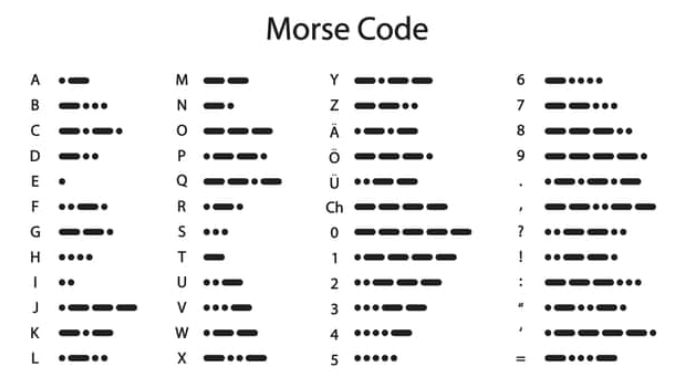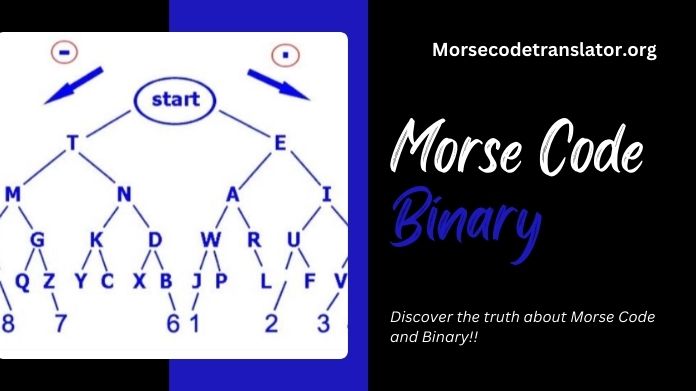Morse Code is a venerable communication system, a symphony of dots and dashes transcending language barriers. However, a common misconception has woven into discussions—Is Morse Code binary?
This Morse Code Translator exploration delves into the heart of this intriguing query, dissecting the interplay between Morse Code binary systems to unveil the facts behind this linguistic enigma.
As we embark on this journey, we aim to demystify the relationship between Morse Code and binary code. Morse Code, known for its simplicity and versatility, has long been an essential tool in telecommunications, but does it share a fundamental language with the binary system?
Join us as we unravel the intricacies, dispel the myths, and illuminate the fascinating connections between Morse Code and the binary world.
How Does Morse Code Work?

Morse Code encodes text characters using sequences of dots and dashes to represent letters, numbers, or punctuation. Samuel Morse and Alfred Vail developed it in the early 1830s for use with their newly invented telegraph. The code has been widely used in various communication systems, including radio and navigation.
Here’s how Morse Code works:
Basic Elements:
- Dot (·): A short signal, often called a “dit.”
- Dash (−): A more extended signal, often called a “dah.”
Representation of Characters:
- Each letter of the alphabet, along with numbers and some punctuation, is represented by a unique combination of dots and dashes.
- For example, the letter “E” is represented by a single dot (·), while the letter “T” is represented by a single dash (−).
Spacing:
- The space between symbols of the same letter is one dot.
- The space between letters is three dots.
- The space between words is seven dots.
Example:
The Morse Code representation of the word “HELLO” is:
- H: ….
- E: .
- L: .−..
- L: .−..
- O: −−−
International Morse Code:
- Morse Code has an international standardized version that is used worldwide. This standard ensures consistency in encoding and decoding across different languages.
Transmission:
- In telecommunication, Morse Code signals can be transmitted using various methods, including sound (as in audible clicks or beeps), light (flashing lights or signal lamps), or on/off keying of an electrical current (as in early telegraph systems).
Adaptability:
- Morse Code is adaptable to various communication environments and can be transmitted through different mediums. It was historically used in maritime and military communication and is still employed in specific contexts today.
Learning and Memorization:
- Morse Code is often learned and memorized using mnemonics, practice sessions, or visual aids that associate the dots and dashes with specific letters or characters.
While Morse Code is no longer a primary means of long-distance communication, it remains a fascinating and enduring system with a unique place in the history of telecommunication.
Morse Code Binary Tree

A Morse Code Binary Tree is a graphical representation of Morse Code characters organized in a hierarchical structure resembling a binary tree. In such a tree, each node represents either a dot (·) or a dash (−), and the path from the root to a particular node defines a specific Morse Code character.
In this binary tree:
- The left branch represents a dot (·), and the right represents a dash (−).
- Each node in the tree corresponds to a decision point in the Morse Code encoding process.
- The leaves of the tree represent Morse Code characters. For example, the letter “E” is represented by a single dot (·), and the letter “T” is represented by a single dash (−).
To decode a Morse Code character using the binary tree:
- Start at the root.
- For each dot encountered, move to the left branch.
- For each dash encountered, move to the right branch.
- Continue until a leaf node is reached, representing a specific Morse Code character.
For instance, decoding “·−” (A) would involve moving left from the root (dot, ·), then right (dash, −), ending up at the leaf node representing the letter “A.”
Creating a Morse Code Binary Tree is a helpful visual aid for understanding the structure of Morse Code encoding and decoding. It clearly represents the relationships between dots, dashes, and the corresponding characters in the code. Remember that the actual tree can be more extensive to accommodate the complete set of Morse Code characters.
What is the Difference Between Morse Code and Binary?
Binary code employs the integers 1 and 0, while Morse code predominantly uses dots and dashes. The dots can be compared to a 0 and the dash to a 1.
You encounter an issue because pauses are also used to specify the dots and dashes. More than any other coding method, Morse code relies on the intervals between signals to provide meaning.
You would still need an additional character, such as a 3, for the spaces if you utilized the dot for a 0 and the 1 for a dash. It would then turn ternary instead of binary at that time. Morse code is not binary; instead, it is more like ASCII.
Conclusion
In our journey through Morse Code and its potential binary connection, the truth unfolds: Morse Code operates on a binary basis but dances to its beat. While dots and dashes echo binary simplicity, Morse Code adds flair, using a binary decision tree to shape its unique language.
Morse Code is a linguistic maestro where simplicity meets versatility. So, while it shares a binary foundation, it crafts a language that sings in dots and dashes, showcasing the timeless elegance of human communication.
The Morse-Binary connection is a captivating dance where tradition and innovation harmonize, leaving us with a symphony encoded in the art of dots and dashes.
